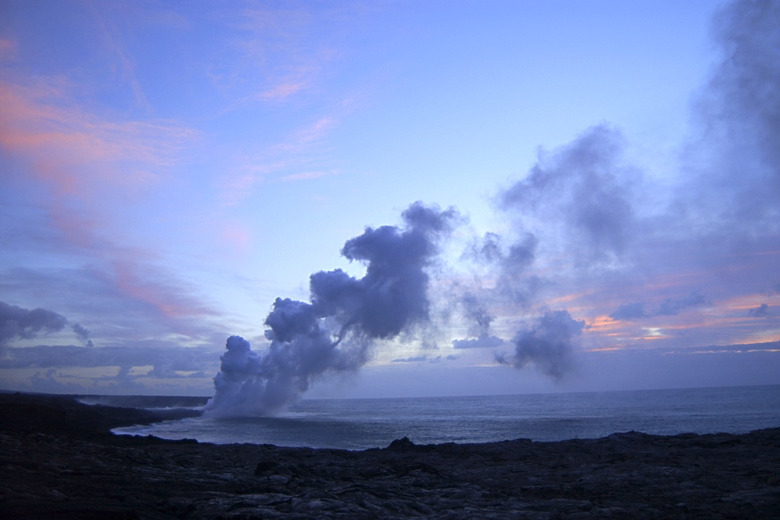What Are The Types Of Eruptions From Most To Least Destructive?
Volcanic eruptions range the spectrum from catastrophic blasts to mild gurgles of lava. Different types of eruptions release different types of materials as well, including lava, steam and other gases, ash and rock. Generally, volcanic eruptions can be classified into five main categories, reflecting the most commonly observed features. However, these labels are applied rather loosely, and volcanoes may display characteristics of more than one eruption type during a single period of activity. Each major general eruption type is named after a well-known volcano exhibiting its characteristic features.
Plinian Eruptions
Plinian Eruptions
Plinian eruptions may go by the name Vesuvian eruptions in some categorization schemes, but are categorized separately in others. Regardless, these eruptions are highly explosive — more than any other eruption type — rendering them extremely dangerous and destructive. Plinian eruptions take their name from the Roman naturalist Pliny the Elder, who died in the historic cataclysmic eruption of Mount Vesuvius in 79 C.E. Plinian eruptions stem from a type of volcano known as a stratovolcano, which often consist of towering peaks such as, of course, Mount Vesuvius, or in the U.S., Washington's Mount Saint Helens. These eruptions entail fiery, fast-moving avalanches of lava. In some cases, an eruption may entail such an overwhelming quantity of lava that the volcano's peak partially collapses in on itself. In addition to lava, during Vesuvian eruptions, volcanoes eject formidable amounts of rock, which can shatter buildings as they crash. Plinian eruptions often also involve the release of copious amounts of ash, which can smother entire towns, as occurred during the famed eruption of Mt. Vesuvius.
Pelean Eruptions
Pelean Eruptions
Like Plinian eruptions, Pelean eruptions are also highly explosive and destructive. Pelean eruptions take their name from Mont Pelee, a volcano on the island of Martinique which erupted catastrophically in 1902, killing nearly 30,000 people almost instantaneously. Pelean eruptions are known for their pyroclastic flows, which contain dense amalgamations of noxious gases, hot ash and other volcanic material. These deadly avalanches can travel down a volcano's slopes at rates of 110 kilometers per hour (about 70 miles per hour), with temperatures estimated up to 370 degrees Celsius (700 degrees Fahrenheit).
Vulcanian Eruptions
Vulcanian Eruptions
Vulcanian eruptions typically involve two stages. First, the volcano shoots out chunks of rock material at high velocities, in a manner similar to canon fire. The volume of matter ejected is relatively small, but it can disperse over a wide area, rendering this stage of eruption hazardous. A cauliflower-shaped ash cloud may develop above the volcano's vent, in which bolts of lightning are frequently observed. The first eruptive stage lasts from a period of a few minutes to a few hours. After this stage, the volcano continues to erupt, but in a gentler manner, spewing forth thick, sticky streams of lava.
Strombolian Eruptions
Strombolian Eruptions
The Strombolian eruption type is named after the volcano on the island of Stromboli off the coast of Italy, which erupts on such a regular basis that it has been nicknamed the "Lighthouse of the Mediterranean." In addition to a pasty type of lava, Strombolian eruptions also involve the ejection of cinder and small rocks, but they don't reach great heights, nor do they scatter widely beyond the volcano's vents. Although they can be quite noisy with loud, booming blasts, Strombolian eruptions aren't considered substantially dangerous.
Hawaiian Eruption
Hawaiian Eruption
Of all the eruption types, Hawaiian eruptions are among the mildest. As their name implies, Hawaiian eruptions are common in the Hawaiian island chain. These eruptions expel less material than all other eruption types, and erupt steadily with thin, runny lava flows. They may, however, occasionally produce fountains of lava shooting brilliantly into the air — but these are a site to behold rather than a force of destruction.
References
- U.S. Geological Survey: Types of Volcanic Eruptions
- San Diego State University: Eruption Types
- San Diego State University: Plinian Eruptions
- Encyclopedia Britannica: Pelean Eruption
- San Diego State University: Vulcanian Eruptions
- San Diego State University: Strombolian Eruptions
- San Diego State University: Hawaiian Eruptions
Cite This Article
MLA
Harris, Amy. "What Are The Types Of Eruptions From Most To Least Destructive?" sciencing.com, https://www.sciencing.com/types-eruptions-least-destructive-12324462/. 24 April 2017.
APA
Harris, Amy. (2017, April 24). What Are The Types Of Eruptions From Most To Least Destructive?. sciencing.com. Retrieved from https://www.sciencing.com/types-eruptions-least-destructive-12324462/
Chicago
Harris, Amy. What Are The Types Of Eruptions From Most To Least Destructive? last modified March 24, 2022. https://www.sciencing.com/types-eruptions-least-destructive-12324462/
